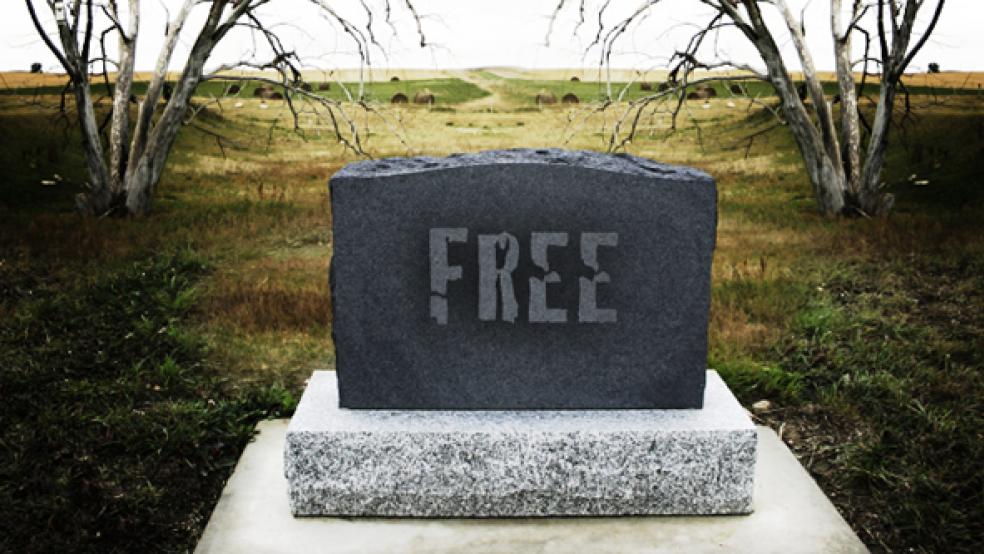Who doesn’t like getting something for nothing?
A few years ago, after the “free movement” took hold, consumers joyfully devoured all their favorite entertainment gratis and guilt-free. In the Wild West of the web, companies were told that they should give away content, music, movies, everything for nothing while a massive audience would build and advertisers would follow.
Companies waited for the windfall. Years later, it turns out, they’re still waiting.
Most experts credit the birth of the free movement to a Silicon Valley hacker convention in 1984 where technology visionary Steward Brand coined the phrase “information wants to be free.” The movement grew with a push for free software like Linux in the 1990s, and later with user-generated online communities like Wikipedia and YouTube. In 2009 Wired magazine's Editor in Chief, Chris Anderson, published Free: The Future of a Radical Price and touted the idea as a long-tail business model. His theory was that as the costs of producing and dispersing creative content falls, giving away most of your product for free becomes a profitable marketing tool. “In the digital realm you can try to keep Free at bay with laws and locks, but eventually the force of gravity will win,” he wrote. Free also meant widespread pirating through companies like Napster and LimeWire.
Suddenly, “free” was a way of life. Traditional business models faced a troubling dilemma: start giving things away or else be obliterated. The race to the bottom for prices had finally hit bottom. At $0.00, there was no where left to go. Newspapers starting posting their content online and stripping away pay walls, companies like Hulu and Pandora cropped up to provide free music and TV shows, Radiohead released a name-your-own-price record, and many others jumped on the free bandwagon. For a few, like Arianna Huffington’s news and blog site, The Huffington Post, it worked better than anyone could have anticipated. In February 2011, AOL acquired the site for $315 million.
But today, more and more companies are realizing it’s lonely at the bottom, and “free” isn’t all that it’s cracked up to be. Author Robert Levine recently published Free Ride: How Digital Parasites are Destroying the Culture Business, and How the Culture Business Can Fight Back, that criticizes the free phenomenon. “Online, we’ve seen a breakdown of the market for information and entertainment,” he says. “Giving things away for free isn’t working.”
This is partly because giving something away for free usually means exploiting someone else. A study by tech consulting agency Envisional and NBC Universal found that nearly a quarter of global Internet traffic consists of pirated content. Part of The Huffington Post’s runaway success was its use of some 9,000 unpaid bloggers. Just one month after the AOL deal, thousands of Huffington’s uncompensated writers and bloggers went on strike and slapped the company with a multimillion dollar lawsuit. “The information that wants to be free is almost always the information that belongs to someone else,” writes Levine. Many companies that took the high route quickly went under. One by one, newspapers like The Rocky Mountain News, The Seattle Post-Intelligencer and Ann Arbor News in Michigan, folded.
But others have fought back. In a shocking move last March, The New York Times announced it had had enough of the free-for-all, and introduced a pay wall. Even more shocking? It seems to be working. The company turned a $15.7 million profit last quarter and currently has 320,000 paid digital subscribers. Two papers that ignored the idea of completely free content: The Wall Street Journal and the Financial Times, are outperforming many of their competitors.
Companies that capitalized on free, user-generated content, or what seemed to be a never-ending stream of unpaid writers seeking a platform, are starting to see that stream become only a trickle. Wikipedia, on the forefront of the free movement and an often-cited model, saw its regular unpaid contributors peak in March 2007 and decline by a third by January 2011. Fewer and fewer new contributors join each month, and growth in the number of articles and edits has plateaued.
What’s more, the companies that started out giving away ad-supported content for free, are realizing that when customers are given the option of an advertisement-free product for a modest price, a surprising number are willing to pay. Music-streaming site Pandora’s paid subscribers have jumped 139 percent year-over-year. Hulu, the popular video-streaming site, which launched a paying option in late 2010, reached over one million paying subscribers in September, less than a year later. Another music-streaming service Spotify, which launched in 2008, currently has over 1.6 million paid subscribers.
Still, there are some signs of life left in the free-content model. Business Insider, which launched in February 2009, pays their 25-plus writers and editors a livable salary (including benefits and bonuses) and gives all their content away for free to some 8 million monthly readers. In 2010, they became profitable. That’s only $2,127 of profits, but still, it’s something. The jury is out on whether the free or paid model --or some hybrid of both -- will really help the bottom lines of companies that have to answer to shareholders and investors.
The thing that seems to be breaking the free model is convenience. Turns out, people care less about rock-bottom prices, and would rather have their music, movies and news at their fingertips, all the time, without long lines, frustrating downloads, viruses, delayed streaming, or a trip to the mailbox, proving that there might be one thing consumers value more than free content – their free time.


